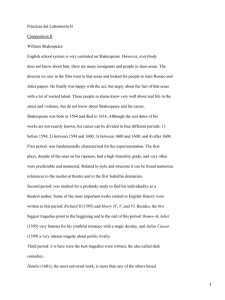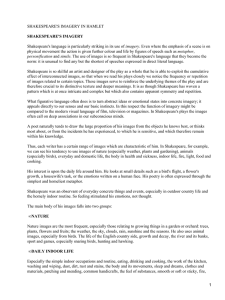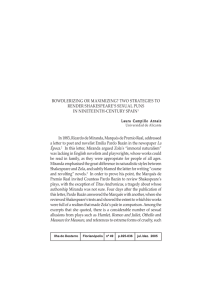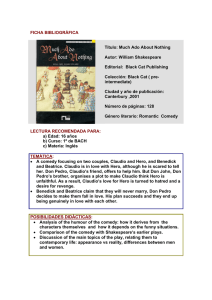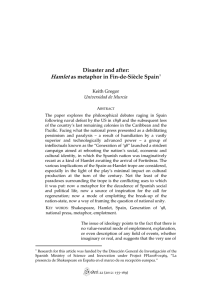Vindicating Pablo Avecilla`s Spanish `Imitation`
Anuncio
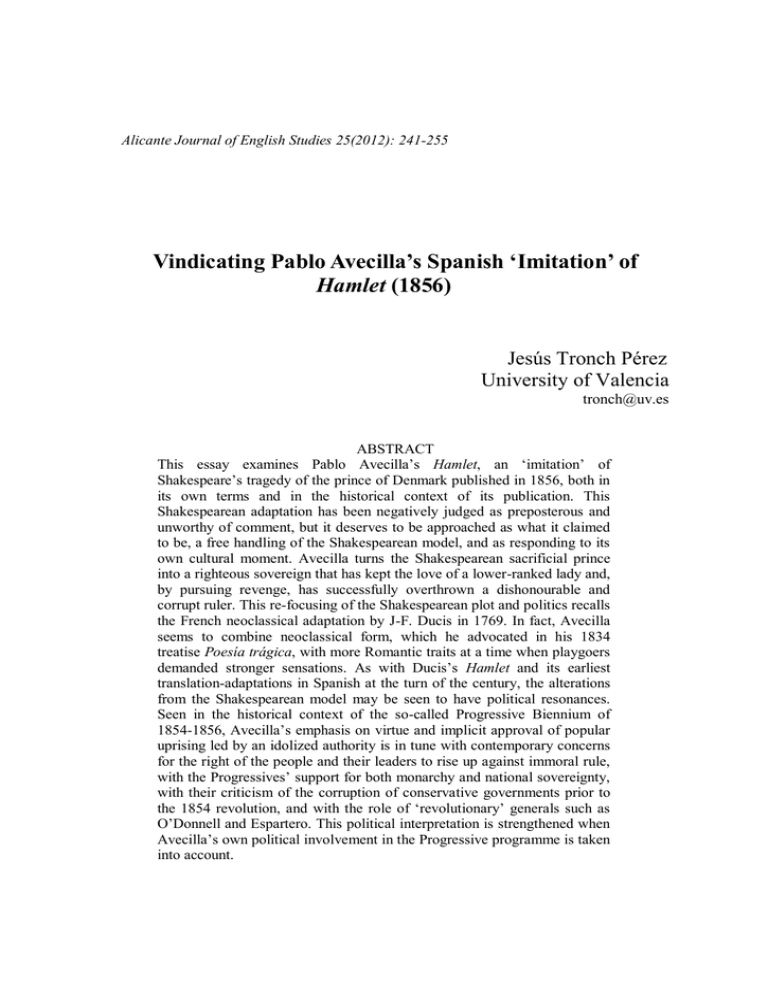
Alicante Journal of English Studies 25(2012): 241-255 Vindicating Pablo Avecilla’s Spanish ‘Imitation’ of Hamlet (1856) Jesús Tronch Pérez University of Valencia [email protected] ABSTRACT This essay examines Pablo Avecilla’s Hamlet, an ‘imitation’ of Shakespeare’s tragedy of the prince of Denmark published in 1856, both in its own terms and in the historical context of its publication. This Shakespearean adaptation has been negatively judged as preposterous and unworthy of comment, but it deserves to be approached as what it claimed to be, a free handling of the Shakespearean model, and as responding to its own cultural moment. Avecilla turns the Shakespearean sacrificial prince into a righteous sovereign that has kept the love of a lower-ranked lady and, by pursuing revenge, has successfully overthrown a dishonourable and corrupt ruler. This re-focusing of the Shakespearean plot and politics recalls the French neoclassical adaptation by J-F. Ducis in 1769. In fact, Avecilla seems to combine neoclassical form, which he advocated in his 1834 treatise Poesía trágica, with more Romantic traits at a time when playgoers demanded stronger sensations. As with Ducis’s Hamlet and its earliest translation-adaptations in Spanish at the turn of the century, the alterations from the Shakespearean model may be seen to have political resonances. Seen in the historical context of the so-called Progressive Biennium of 1854-1856, Avecilla’s emphasis on virtue and implicit approval of popular uprising led by an idolized authority is in tune with contemporary concerns for the right of the people and their leaders to rise up against immoral rule, with the Progressives’ support for both monarchy and national sovereignty, with their criticism of the corruption of conservative governments prior to the 1854 revolution, and with the role of ‘revolutionary’ generals such as O’Donnell and Espartero. This political interpretation is strengthened when Avecilla’s own political involvement in the Progressive programme is taken into account. 242 Alicante Journal of English Studies In 1856, the lawyer, writer and member of the Spanish parliament Pablo Avecilla (1810-1860) published his stage ‘imitation’ of Shakespeare’s Hamlet.1 Now a minor figure overlooked in major literary histories, Avecilla was then known as the author of a few historical and legendary dramas, socially-concerned comedies, historical novels, various dramatic, legislative, mercantile and military studies, and political articles, as well as the editor of a collection of successful plays entitled “España dramática” (Cotarelo 1928; Martínez Olmo 2008: 33-40). In the context of Avecilla’s editorial venture, his Hamlet, drama en cinco actos aimed to provide the Spanish theatre, “flooded with French productions”, with an example of English drama (1856: 3). As explained in his preface, he found Shakespeare’s tragedy “impossible to stage with all its defects” —a critique with neo-classical resonances— and carried out a thorough revision of plot and characters: “it became necessary to change the pace and denouement of the action; to change the personality of characters and shape them according to a more rational use … and to rescue the magnificent and surprising poetic scenes offered by Shakespeare” (1856: 3). Searches in the digital periodical archive of the Biblioteca Nacional have produced no record of performances at that time, as Par had already pointed out (1936: 199), or of contemporary reviews or appraisals of this piece. Spanish Shakespeare scholars have negatively judged this adaptation. Juliá briefly points out some distinctive features, such as Ofelia being no more than a court lady “with whom the prince flirts” and judges the play not worthy of any further comment (1916: 127). Par deemed it “preposterous” and a “rough echo of an outdated neoclassicist doctrine” (1935: 255), termed Hamlet “a scrupulous mystic” and in his summary of Avecilla's adaptation calls him “mentecato” [“silly”] (1936: 200, 268). Two assumptions underlying these jabs are questionable. On the one hand, they judge the adaptation as failing to achieve what it did not aim at. They seem to be based on the expectation that an approach to Shakespeare’s tragedy should respect its integrity while in fact Avecilla offered, as the title page reads, a “drama” (see below for a discussion of the term) and “an imitation of Shakespeare by Don Pablo Avecilla”. Rather than the present-day sense of mimesis, “imitation” points to the creative, stylistic exercise of copying or adapting a literary model (Else & Elam 1993: 576-7). Avecilla’s is neither a translation nor a more or less straight stage adaptation; it is his play and not Shakespeare’s, although he acknowledges his indebtedness to the English playwright. In the preface, Avecilla frankly describes his free handling of the Shakespearean model. One could assume that Avecilla’s respect for Shakespeare was such that he even respected the ‘canonical’ text of Hamlet in Spanish at that time: the prose translation by the renowned neo-classical dramatist and poet Luis Fernández de Moratín published in 1789, whose Hamlet is the first integral translation of a Shakespeare play into Spanish. It was reprinted in the third volume of Obras dramáticas y líricas de D. Leandro Fernández de Moratín in Paris in 1825 and in 1826. As Avecilla states in his preface, his “imitation” rescued “the magnificent and surprising poetic scenes offered by Shakespeare, rendered into Spanish by Moratín’s inimitable quill”. What remains of Shakespeare’s tragedy in terms of dialogue is an almost literal transcription of Moratín’s prose; the rest of the drama is Avecilla’s words Vindicating Pablo Avecilla’s Spanish ‘Imitation’ of Hamlet (1856) 243 and actions. What should be of interest, therefore, is not to assess Avecilla’s Hamlet according to a pre-conceived adherence to its source but to describe and explain this Spanish Hamlet play of the 1850s in its own terms as “imitation”, as well as being in tune with or responding to its own cultural moment. Those unfamiliar with Avecilla’s Hamlet may wish to read a detailed synopsis (in the appendix) before engaging in the discussion this article will unfold in sections I and II. I. Avecilla’s Hamlet as an ‘imitation’ In his preface, Avecilla warned readers that it was necessary to change the denouement of the action, and this is in fact the most surprising creative adaptation in his ‘imitation’: Hamlet, victoriously acclaimed as future King of Denmark, outlives his uncle Claudio, and so do his mother Gertrudis, Ofelia and Polonio. The shift in genre is significant. Avecilla reshapes a tragedy into what can be termed a ‘drama’: a type of play with a serious subject and tone without involving the tragic death of its protagonist. 2 Let us remember that the title of Avecilla’s play is simply “Hamlet”, not “The Tragedy of Hamlet” as in the First Folio or “The Tragical History of Hamlet” as in the earlier quartos; and that the subtitle is “drama en cinco actos” (Spanish for ‘play’ or ‘drama in five acts’), followed by “imitación de Shakespeare” (as explained above). There is an obvious connection with the influential French adaptation by JeanFrançois Ducis, first staged in 1769, in which the young King Hamlet, after killing the usurper Prince Claudius, lives on, as do Gertrude, Ophelie and Polonius. Avecilla’s publishing venture took him to Brussels, London and Paris (Sociedad 1854: 318), where he might have come across Ducis’ Hamlet, performed at the Comédie Française until 1851 (Heylen 1993: 29). It is interesting to observe that Ducis’ neoclassical piece has the subtitle “tragédie imitée”. Avecilla’s “drama” similarly follows the neoclassical precepts of unity of time (approximately a day and a half), of place (inside and outside the Danish royal palace in Elsingor), and of action, with no secondary story-lines dealing with Laertes, Ofelia’s madness or Fortinbras, and with a reduction of the speaking parts to ten roles (eight in Ducis): Hamlet, Claudio, Gertrudis, Ofelia, Horacio, Polonio, the guards Marcelo and Cornelio, and two gentlemen. As in Shakespeare, Horacio and Polonio are the “helpers” of the protagonist and antagonist respectively, matching them in age, but in Avecilla they have equal social status: sumillers de corps (or high officers of the royal household). One may easily assume that these changes from the Shakespearean model are part of Avecilla’s plan to “shape” the English play “according to a more rational use”, thus removing “its defects” (1856: 3). Par argued that Avecilla’s neoclassical approach was at odds with Shakespeare. Besides the observation of classical unities, Avecilla’s neoclassicism can be seen in his vocabulary, and his invocation of both Christian divinity and pagan gods recall neoclassical style (Par 1936: 200; Argelli 1997: 183). However, just as Ducis was swinging from French classical tragedy to bourgeois drama (Heylen), Avecilla could be seen to combine neoclassical form, which he advocated in his 1834 treatise Poesía trágica, 244 Alicante Journal of English Studies with more Romantic traits at a time when playgoers demanded stronger sensations (Shaw 1983: 137). These Romantic features could mainly be the ghost (however mute), the character of the prince (both despondent and impassioned, sometimes to the point of delirium), the play’s emphasis on terror (especially in all of Act II), and the emotional turmoil of the equivalent to the ‘closet scene’ (Act IV). In his treatise, Avecilla had stated that “Shakespeare, with all his monstruosity and lawlessness, is the first to provide the pulse of the new Romantic poetry”. Together with Romantic Spanish writers such as José Espronceda and Ventura de la Vega, Avecilla was a sub-editor of the journal El Siglo, which rejected eighteenth-century precepts and doctrines because they “degraded imagination and ridiculed the noble passions of the human heart” (quoted from Pont 2008: 18). Perhaps for Avecilla, Shakespeare’s Romanticism was seen in “the magnificent and surprising poetic scenes” he rescued in his adaptation. Like Shakespeare, Avecilla focuses on the hero’s private revenge on his father’s murderer (a perfidious regicide), but the Spanish author makes the prince an undithering and more determined avenger. His Hamlet uses the term “revenge” and its derivatives more often throughout the play (and so does Horacio), to the extent that, although melancholy and sceptical, the prince seems to be almost obsessed with the idea of revenge. Avecilla’s hero is not the meditative prince3 (there is no trace of the “To be or not to be” monologue) with a questioning attitude towards the ethics of revenge and towards the moral basis of any course of action he is to undertake. And when one realizes that Avecilla used Shakespeare’s plot as far as the first lines of 4.1(probably to comply with the unity of time) and kills Claudio while in the orgiastic pleasures of a banquet, one clearly perceives that Avecilla in fact materializes Hamlet’s cruel desire in 3.3 to condemn his uncle to hell, thus repaying the murderer of his father for what the latter is suffering in purgatory. The drama’s very last words, “Heaven and Hamlet are revenged”, spoken by the prince, hammer home both the play’s extra emphasis on the theme of revenge and on the shaping of its hero as a “providential revenger” (Bevington, 2002: 135). In Shakespeare, Hamlet realizes that “There’s a divinity that shapes our ends” (5.2.10), after his experience on the ship to England. There, when his revengeful design was losing force, an instinctual impulse (“Rashly” 5.2.6) leads him to discover the King’s instructions to have Hamlet executed in England, that is, not only further proof of his uncle’s guilt but also an ultimate justification for preventing his uncle, described as a “canker”, to “come in further evil” (5.2.69-70). Bound to the unity of time, Avecilla cannot allow his hero time to reflect on the providential character of these events while travelling to England. In compensation, Avecilla inserts the idea of Providence at the very first moment “revenge” is mentioned in the play: when Hamlet suspects some “foul deed” in I.iv.4 From that moment on, revenge and Providence will be connected until the very end. Avecilla also shapes his prince as deeply “melancholy”, another notion that is used more frequently than in Shakespeare, both in the dialogue and in stage directions. A “virtuous”, “sensitive”, “hapless young man”, this Hamlet is also vehement, easily enraged, showing sudden changes of mood, capable of dissembling calmness and joy (I.v) and of hurling of veiled accusations at the monarchs (III.ii). These are also traits of Vindicating Pablo Avecilla’s Spanish ‘Imitation’ of Hamlet (1856) 245 the Shakespearean prince. However, unlike Shakespeare, Avecilla portrays his hero as pious —Ofelia even suspects that he “mortifies his body” (Avecilla 1856: 10)— and sometimes clearly “deranged” (“enajenado” in Spanish, as one stage direction specifies in the final scene). His dejection and constant melancholy do not allow him to play evasively with language (as Shakespeare’s Hamlet does in the ‘fishmonger’ episode and in 4.3, cut by Avecilla), and to treat Ofelia with cruelty (the only trace of the ‘nunnery scene’ is a speech in III.vii by Hamlet, who in a temporary fit of anger rejects Ofelia). Turning now to other characters in the play, the antagonist (Claudio) is intelligent and passionate, always suspects his nephew, but shows no remorse as Shakespeare’s Claudius does in 3.1.48-53 and 3.3.36-72. To a certain extent, it could be argued that Avecilla transposes Claudius’s remorse to a repentant Gertrudis in V.vii. He also does not plot the execution of Hamlet, thus appearing a less complex character, an “unsympathetic” and “pasteboard villain”. These terms are used by Irace to describe the King in the First Quarto version of Hamlet published in 1603. The only villain in the play (the only character that dies), his evil nature is increased when he forsakes his wife in the final scene, a portrayal that justifies Hamlet’s killing even more. Gertrudis is a solicitous mother and a passionately loving spouse to Claudio. Both facets are portrayed more emphatically than in Shakespeare through repetitions of motifs and attitudes in several scenes. Far from the ambiguous figure in Shakespeare, she clearly reveals in III.iv her complicity in the murder of her first husband (in Ducis she leaves the poisoned cup beside her husband’s bed). The fact that the audience knows about her guilt adds dramatic irony to the equivalent ‘closet scene’ in IV.iii. Torn by divided loyalty towards husband and son (IV.vi) and stung by remorse, a repentant Gertrudis finally takes refuge in prayers in contrast to Claudio’s abandoning himself to courtly pleasures. Understandably, Avecilla saves her from the tragic death Gertrude meets in Shakespeare’s play. The Ophelia figure does not go mad and die (nor does she in Ducis), but in Avecilla her role as Hamlet’s lover is more prominent as instrumental in the single, principal action centred on the prince’s vengeance. On the one hand, Hamlet is taking advantage of, and contributes to, the well-spread belief that his melancholy is due to Ofelia’s rejection, an attitude that Gertrudis insistently seeks to redress. On the other, Ofelia’s relationship with Hamlet bears on the political tensions in Denmark: Claudio opposes a marriage between Hamlet and Ofelia invoking the ancient customs of the country, while Polonio acknowledges that the Danish people, who idolize the prince, would support this marriage; and this union will be used by Hamlet to oppose Claudio’s plans to send him away from the court. However, the love relationship between Ofelia and Hamlet is neither developed into a secondary story-line (they are never alone onstage) nor resolved at the end of the play: although the audience may infer that they will be married, neither is she onstage in the final scene nor is any single line said about their future. From a neoclassical perspective, the unity of action does not permit this subplot. Avecilla’s Horatio is also described by Hamlet in terms of equanimity and stoic temperament, but he encourages the prince to take revenge and follows Hamlet’s secret instructions to spread rumours that will help him in his plot against his uncle. 246 Alicante Journal of English Studies In his “imitation”, Avecilla proves to be as skilful as many previous and later adapters of Shakespeare’s tragedy when time and action need to be reduced in order to change the “pace”of the action, as he states in his preface. For instance, as many stage adaptations do,5 Avecilla begins his play in Shakespeare’s 1.2, where he aptly condenses episodes and speeches from 1.3, 2.1, 3.2 and 2.2. The ghost’s appearance in 1.1 is transposed to Act II, which is entirely devoted to the encounter with the ghost in combination with episodes from 1.4 and 1.5. This second act is set outside the palace in a terror-inspiring night of continuing thunder and lightning. The ghost never utters a word (perhaps to comply with a certain neoclassical notion of verisimilitude) and consequently the narrative of the murder is reported by Hamlet in direct speech. Other re-assignments of speeches or lines to different characters are aptly carried out, such as when in I.ii Laertes’s admonition to Ophelia is given to her father since the Laertes figure is cut. Time is also saved when, as Act IV begins, the audience is told that a playwithin-the-play, which is necessary for Hamlet to confirm the ghost’s revelation, has already taken place (offstage). The embassy to England (to negotiate with Fortimbrás) is also retained not just as the only hindrance that delays Hamlet’s revenge (though only for a few hours), but also because it is a necessary event for the political uprising plotted by Hamlet. Early twentieth-century appraisals of Avecilla’s prince may be right in missing fundamental aspects of the Shakespearean hero in Avecilla’s revenge-obsessed prince, but we should bear in mind that in the 1850s Spaniards did not have a dominant image of Hamlet akin to the received notion of the hesitating and metaphysical prince. It is from the 1860s, after performances of the Italian actor Ernesto Rossi in Spain, that ideas of Hamlet related to the phenomenon of Hamletism started to circulate. 6 To conclude this section, Avecilla turns the Shakespearean sacrificial prince into a righteous sovereign that has kept the love of a lower-ranked lady and, by pursuing revenge, has successfully overthrown a dishonourable and corrupt ruler. In addition, Avecilla more closely links Hamlet’s private vengeance to the love between the prince and Ofelia, a relationship with political implications, since their union is favoured by the Danish people and opposed by the king. These political implications will be explored in the next section. II Since Hamlet deals with usurpation and the legitimacy of monarchial power, court intrigues and territorial conquest, it is not surprising that it incites political resonances, as is the case with the earliest stage Hamlets in France and other European countries. As Heylen mentions, Ducis’s adaptation was “modified occasionally to conform to political fluctuations” (1993: 43) and similar changes have been observed in the earliest Shakespeare-related performances or theatre scripts in Spain, derived from Ducis. In fact, Spain is the European country where the earliest translation-adaptation of Ducis’s Hamlet was made and is a unique case in having adapted it in four different versions, as Pujante and Gregor state (2005: 129-30). Between the 4th and 8th of October 1772, the Vindicating Pablo Avecilla’s Spanish ‘Imitation’ of Hamlet (1856) 247 Madrid playhouse Corral del Príncipe performed Hamleto, rey de Dinamarca [Hamleto, King [sic] of Denmark] (Cotarelo 1928; 269-70; Par 1936: 21), a slight adaptation of Ducis’s first version of Hamlet, attributed to the popular and successful dramatist Ramón de la Cruz (see Pujante and Gregor 2010: 351-53, for a discussion of the attribution). As Parisian playgoers did, spectators in the Spanish capital saw in this Hamleto not the reflective prince questioning revenge, but a young king with divided duties towards father and lover, resolving them with exemplary virtue in a general dynastic conflict in which he was eventually victorious over the rebellion of Prince Claudio (father of Ophelia, and not Hamlet’s uncle). As Pujante and Gregor explain (2008), some of the Hamleto-writer alterations from the French dramatist enhance the latter’s endorsement of the political status quo: the emphasis on terms such as “vassal”, “loyal followers” and “rebels” and minor additions such as making Hamlet appear at the end of the play as a king who forgives the conspirators, reinforce a sense of loyalty to the monarchy and of condemnation of rebellion, perhaps alluding to the riots in 1766 against Minister Esquilache. The second Ducis-derived version of Hamlet is preserved in an anonymous manuscript in Santander, perhaps written after 1800 (Pujante and Gregor 2005: 132). This translator-adaptor, the first to mention Shakespeare as the originator of the story, removes the entrance of Ofelia and Norceste (the Shakespearean Horatio) in the final scene, and inserts words such as “vassal”, “rebel” and “regicide” (a term put into circulation again after the execution of the French king Louis XVI in 1793) that enhance the figure of Hamlet as a victorious king who supports the old regime and punishes regicides such as Claudio as a warning to would-be conspirators (Pujante and Gregor 2008). Besides, in a preface to the play, the translator himself stated that “filial love and respect […] is the essential argument of the piece, and Hamlet can be taken as a model of affections”, and that due to its “excellent morality, honest sentiments and judicious sayings spectators could profit from its performance” (Santander manuscript [preface]). The Hamlet shaped by the lawyer, playwright and translator Antonio de Saviñón (1768-1823) comes across as a more suffering hero, as his attitude towards his mother is softened (Pujante and Gregor 2005: 138). He used Ducis’s later version, which, as Golder argues, underlines the theme of legitimization of royal power against conspiracy (1992: 64). This political concern might have appealed to Saviñón’s purpose of offering a play whose hero is a king that succeeds in defeating usurpers and in gathering a large popular support, which would have been in tune with the 1812 liberal Constitution’s emphasis on the sovereignty of the people (Pujante and Gregor 2008). The fourth Hamlet stemming from Ducis, that in José María de Carnerero’s manuscript dated 1825, was penned at the time of Ferdinand VII’s reactionary politics suppressing what remained from the Liberal Triennium of 1820-1823. This Hamlet can be said to embody the values of the old regime while Claudio’s followers recall the “revolutionaries” of 1789 France (Pujante and Gregor 2008). Some of Carnerero’s additions turn Hamlet’s revenge into an issue of outraged honour, much as in Spanish 248 Alicante Journal of English Studies Golden Age drama, towards which contemporary dramatists were looking (Pujante and Gregor 2005: 137-9). In 1856, when Avecilla published his Hamlet, the reign of Isabella II had provisionally silenced the reactionary and legitimist movement supporting her uncle Don Carlos’s claim to the throne (with civil wars between 1833 and 1839 in some regions, and between 1846 and 1849 in Catalonia), as shown by Carr (1966) and Kiernan (1966). Yet it was still suffering from the tensions between conservative and progressive fronts of liberalism, which often surfaced as military rebellions led by generals who actively participated in the hot politics of the country. An uprising in July 1854, led by the conservative political general Leopoldo O’Donnell and prompted by discontent with the authoritarianism, corruption and immorality of the government of the more conservative Moderate Party, ignited a short revolutionary movement across the country. With the support of General Baldomero Espartero —former Regent, progressive Prime Minister, exiled, and still popular— this revolution forced the queen to place the Progressive party back in power with Espartero renewing as Prime Minister. The liberal regeneration of the so-called Progressive Biennium of 1854-1856 was brought to an end by another coup in July 1856, again led by O’Donnell, who chaired the government with his Liberal Union party only to be superseded by General Narváez and the Moderate party a month later. In the context of the Progressive Biennium of 1854-1856, the politics of Avecilla’s Shakespeare-inspired play could have specific resonances. His imitation can be interpreted as being in tune with contemporary concerns for the right of the people and their leaders to rise up against immoral rule, as had been the case in the 1854 uprising. As in Ducis’s imitation and its Spanish derivatives described above, in Avecilla’s play Hamlet emerges as a figure of the righteous would-be monarch who has defeated the regicide and perfidy embodied in Claudio. Yet while Ducis’s Hamlet is a king who is able to put down a conspiracy, Avecilla’s prince can be seen as a charismatic leader who, although driven by private revenge, organises a plot to topple a depraved king with the support of both the people and the rebel army. This image would not be dissimilar to that of “revolutionary” generals, particularly of Espartero, who achieved power (and to some extent took his private revenge by putting out of office the Moderates that had exiled him eleven years before) through a rebellion supported by the army and the people. Unlike Shakespeare, Avecilla stresses Hamlet being loved, even idolized, by the people throughout the play (1856: 11, 33, 41, 46). When discussing the plan to send Hamlet away in 3.4, Claudio acknowledges that he is “loved by the fanatic multitude” (1856: 30), and later in 4.5 that he is “loved by the army” (1856: 42). The play’s emphasis on the virtue of Hamlet —a particular concern of Avecilla’s, whose previous play Caibar emphasized virtue as the keystone for the throne and for the future of a country— would be in tune with the words of O’Donnell at the July 1854 uprising claiming “to preserve the throne but without the ‘camarilla’ [crony cabinet] that dishonours it”,7 and with the words of Espartero at the opening session of the new Parliament on 28 November 1854: “the country counts on your efforts, on your virtues, on your wisdom, in order to pass laws that guarantee its rights and destroy the abuses of Vindicating Pablo Avecilla’s Spanish ‘Imitation’ of Hamlet (1856) 249 the late government”.8 These are examples of the revolutionaries’ discursive practices that would chime with Avecilla’s portrayal of Claudios court as immoral and dishonourable and of Hamlet as its scourge. Arguably, the politics of the Hamlet story could be said to echo any successful uprising, whether conservative or progressive, and the episode of the prince being sent away would remind Spaniards of similar situations in which Spanish royals were removed from the court because of political pressures. But the temporal proximity of the 1854 revolution to the date of publication (and probable composition) of Avecilla’s Hamlet make it more likely that it participated in the discourse of the Progressive biennium. This political interpretation is strengthened when we look at Avecilla’s own political leaning. As we can learn from an anonymous biography in the panegyric compilation Asamblea constituyente de 1854 (Sociedad 1854: 314-28), Pablo Avecilla was the orphan of a liberal father who died during the 1823 repression. He wrote a patriotic hymn honouring the 1823 victims, and in 1833 was offered an administrative post in the Canary Islands as a “banishment” from the court for being part of a group of “fiery young men crying against the government” (Sociedad 1854: 316-7). A follower and friend of General José Rodil, supporter of Espartero and Prime Minister between June 1842 and May 1843, Avecilla could have held a position in the Progressive cabinet (Sociedad 1854: 325). In 1845, when the Moderates were in power, he was suspected of conspiracy and arrested (325). In 1849 he distinguished himself as a harsh critic of the government’s administrative policies (Sociedad 1854: 326), and in 1854 was elected as a member of the constituent assembly for the province of Segovia for the period 18541856 (Estadística 1858: 306, 464). Even though we lack documentary evidence for a presumed political purpose in Avecilla’s imitation, it would not be surprising that a Progressive politician and writer looking at Hamlet at that time would pay attention to the political connotations of a story about power in the hands of an immoral ruler and would aggrandize those reverberations into specific dramatic events and characterizations that would support the justifications of the Progressive revolution. The Progressive programme did not question monarchism (as more reformists would later move toward republicanism) but advocated national sovereignty (although through census suffrage, not universal suffrage). In Avecilla’s play, monarchy is not challenged but preserved when Hamlet becomes the righteous king who has overthrown the perfidy of the previous ruler, a concern of progressive intellectuals who, like Avecilla, descried the corruption of Isabella’s conservative governments. The play’s implicit approval of a popular uprising led by an idolized authority would, in 1856, have been welcomed more by Progressive sympathies than by the defeated conservatism. One may wonder, then, whether the fact that Avecilla’s Hamlet was apparently never staged and generally ignored may be related to the political failure of the so-called Progressive Biennium, in which Avecilla actively participated, and which was brought to an end through a military coup in July 1856. 250 Alicante Journal of English Studies Notes 1. This article is an expansion of a paper presented at the 9th International ESRA Conference held in Weimar in April 2012. For the first version I wish to acknowledge the support of the Research Project FFI2008-01969/FILO; and for the expansion, the support of the Research Project FFI 2009-12730 (in its turn, part of CSD 2009-00033 within the Consolider Ingenio programme) all financed by the Spanish government. 2. See “drama”, sense 1b in the Merriam-Webster Dictionary, <http://www.merriamwebster.com/dictionary/drama> (accessed 31 August 2012) 3. Although the stage direction at I.iv (p. 13) instructs “Queda en profunda meditación”, this is just a symptom of his melancholy. 4. “Aunque las entrañas de la tierra oculten los crímenes, la Providencia vela para su venganza” (1856: 13). This phrase is a modulation of “Foul deed will rise, Though all the earth o’erwhelm them, to men’s eyes” (1.2.256-7), with the addition of “Providence watches over for its vengeance”. 5. For instance, the many nineteenth-century English stage versions that Hapgood cites (1999: 7), and the Spanish stage versions by Ramón de la Cruz (1772), J. M. Carnerero (1825) –which are in fact renderings of Ducis’s–, Carlos Coello (1872), Martínez y Artabeitia (1872), and Pérez Bibbins and López Carvajal (1886). 6. For the role of Rossi’s and other Italian productions in disseminating and popularizing Shakespeare in Spain, see Par (1935: 15-21; 1936: vol. 2, 7-8). For a brief cultural history of “Hamletism”, see Foakes (1993: 12-44). 7. “Nosotros queremos la conservación del Trono, pero sin la camarilla que le deshonra” (Nido 1911: 95-6; Tuñón 1976: 172). For a specific contextualization, see Kiernan (1966: 4667 and 109-120). Included in the so-called “Manifiesto de Manzanares” or “Programa de Manzanares”. 8. “la Patria cuenta con vuestros esfuerzos, con vuestras virtudes, con vuestra sabiduría, para que hagáis leyes que afiancen sus derechos y destruyan los abusos que se han introducido en el gobierno del Estado” (Nido 1911: 147). References Argelli, Annalisa (1997): La presencia de Shakespeare en la literatura española de los siglos XVIII y XIX. Cuatro dramas ejemplares: Hamlet, Romeo and Juliet, Othello y Macbeth. Diss. Universidad Autónoma de Madrid. Microfiche. Madrid: Ediciones de la Universidad Autónoma de Madrid. Avecilla, Pablo (1856): Hamlet, drama en cinco actos, imitación de Shakespeare. Madrid: Imprenta C. González. References to act and scene in Avecilla’s Hamlet appear in Roman numerals. ––––– (1851): Caibar: drama bardo en tres actos y en verso. Madrid: Imprenta C. González. ––––– (1834): Poesía trágica. Madrid: Librería Europea. Bevington, David (2002): Shakespeare. Malden, MA, and Oxford: Blackwell. Carr, Raymond (1966): Spain, 1800-1939. Oxford: Clarendon Press. Cotarelo, Emilio (1928): “Editores y galerías de obras dramáticas en Madrid en el s. XIX”. Revista de la Biblioteca, Archivo y Museo del Ayuntamiento de Madrid (18 Abril): 121139. Vindicating Pablo Avecilla’s Spanish ‘Imitation’ of Hamlet (1856) 251 Else, G. F and H. R. Elam (1993): “Imitation”. In A. Preminger and T.V. F. Brogan, eds., The New Princeton Encyclopedia of Poetry and Poetics. Princeton: Princeton University Press, 575-79. Estadística del personal y vicisitudes de las Córtes y de los Ministerios de España (1858). Madrid: Imprenta Nacional. Evans, G. Blakemore, ed. (1997): The Riverside Shakespeare. 2nd edition. Boston: Houghton, Mifflin. Line references in Shakespeare’s Hamlet are keyed to this edition. Foakes, R. A. (1993): “Hamlet” versus “King Lear”: Cultural Politics and Shakespeare’s Art. Cambridge: Cambridge University Press. Golder, John (1992): Shakespeare for the Age of Reason: The Earliest Stage Adaptations of Jean-François Ducis, 1769-1792. Oxford: The Voltaire Foundation. Hapgood, Robert, ed (1999): William Shakespeare: Hamlet. Shakespeare in Production. Cambridge: Cambridge University Press. Hemeroteca Digital, Biblioteca Nacional,<http://hemerotecadigital.bne.es/index.vm > (accessed 25 June 2012). Heylen, Romy (1993): “Jean-François Ducis’ Hamlet, Tragédie imitée de l’anglois: A Neoclassical Tragedy?”. In Translation, Poetics and the Stage: Six French Hamlets. London and New York: Routledge, 26-44. Juliá Martínez, Eduardo (1918): Shakespeare en España: traducciones, imitaciones e influencia de las obras de Shakespeare en la literatura española. Madrid: Tipografía de la Revista de Archivos, Bibliotecas y Museos. Kiernan, Victor (1966): The Revolution of 1854 in Spanish History. Oxford: Clarendon Press. Martínez Olmo, Pilar (2008): La España Dramática. Colección de obras representadas con aplauso en los teatros de la corte (1849-1881). Madrid: CSIC. [Moratín, Leandro Fernández de] Celenio, Inarco, trans. (1798): Hamlet.Tragedia de Guillermo Shakespeare. Traducida é ilustrada con la vida del autor y notas críticas por Inarco Celenio. Madrid: Villalpando. Rpt. in Obras dramáticas y líricas de D. Leandro Fernández de Moratín. Vol. 3 París: Augusto Bobée, 1825. Rpt. in Obras. Vol.3. Madrid: Academia de la Historia, 1830. Rpt. in Ríos Carratalá, J. ed. Digital edition Hamlet. Tragedia de Guillermo Shakespeare. Traducida é ilustrada con la vida del autor y notas críticas por Inarco Celenio, 1798 at <http://www.cervantesvirtual.com/obra-visor/hamlet-tragedia-1/html/> Nido y Segalerva, Juan (1911): Antología de las Cortes desde 1654 á 1858. Madrid: Congreso de los Diputados. Par, Alfonso (1935): Shakespeare en la literatura española. Vol. 1. Madrid: Librería General de Victoriano Balmes; Barcelona: Biblioteca Balmes. ––––– (1936): Representaciones shakespearianas en España. Vol. 1. Madrid: Librería General de Victoriano Suárez; Barcelona: Biblioteca Balmes. Pont, Jaume (2008): “La narrativa breve de Antonio Ros de Olano”. In Antonio Ros de Olano: Relatos. Barcelona: Crítica, 7-102. Pujante, Ángel-Luis, and Keith Gregor, eds (2010): ‘Hamlet’ en España: Las cuatro versiones neoclásicas. Salamanca: Ediciones Universidad de Salamanca; Murcia: Editum. ––––– (2008): “Conservatism and Liberalism in the Four Spanish Renderings of Ducis’s Hamlet”. In D. Delabastita et al., eds., Shakespeare and European Politics. Newark: University of Delaware Press, 304-317. ––––– (2005): “The Four Neoclassical Spanish Hamlets: Assimilation and Revision”. SEDERI 252 Alicante Journal of English Studies 15: 129-44. Santander. Hamlet, anonymous and undated ms. M-4 (formerly R. 1-7-55). Biblioteca Menéndez Pelayo, Santander. Shaw, Donald L. (1983): Historia de la literatura española: El siglo XIX. Vol. 5. Trans. Helena Calsamiglia. [Trans. of A Literary History of Spain. The Nineteenth Century. London: Ernest Benn, Ltd. 1972] Barcelona: Ariel. Sociedad Literaria, Una (1854): Asamblea constituyente de 1854: Biografías de todos los diputados y todos los hombre célebres que han tomado parte en el alzamiento nacional. Madrid: Imprenta de Julian Peña. Tuñón de Lara, Manuel (1976): La España del Siglo XIX. Barcelona: Laia. Appendix: A synopsis of Avecilla’s Hamlet Act I: In the great hall of the royal palace of Elsingor. Scene i: Claudio, King of Denmark, justifies his marriage to his brother’s widow Gertrudis, and vows to prove a worthy successor of his virtuous brother and a loving father to Prince Hamlet. Gertrudis and Claudio try to persuade the melancholy prince to lay aside his affliction over his father’s demise. Claudio announces Hamlet as “the most immediate to our throne”. Scene ii: Polonio, an old sumiller de corps (high officer of the royal household), exhorts his daughter Ofelia to end her relationship with Hamlet, and warns her against his youthful temperament and royal status. Ofelia recounts Hamlet’s strange behaviour on one of his visits, and this confirms Polonio’s suspicion that Hamlet’s melancholy is caused by his daughter’s rejection. Scene iii: Hamlet praises Horacio (also a sumiller de corps) for being a “man that is not passion’s slave”. Horacio, and the guards Marcelo and Cornelio tell the prince of the apparition of a ghost that resembles his father. Hamlet will watch that night with them. Scene iv: Alone, Hamlet suspects “foul play” and trusts that Providence will take revenge. Scene v: A deeply meditative Hamlet replies to Claudio, Gertrudis and Polonio that man is but the “quintessence of dust”. Then he vehemently expresses that love has taken away his mirth and health, and goes out to pray for his dead father. Scene vi: Polonio reads out a love letter Hamlet sent to Ofelia, which confirms Gertrudis’s belief that Hamlet’s happiness can be restored through Ofelia. Claudio, however, suspects that love is not the only cause of Hamlet’s distress. Act II: At night on the esplanade before the palace. Scene i: Marcelo and Cornelio, on watch, describe the terrifying tempest going on. Scene ii: Horatio joins them and seeks to explain the apparition of the ghost as a bad omen for the unhappy state of Denmark, as in ancient Niniveh before Ninus fell. The Ghost comes again while Marcelo and Cornelio are recounting its first apparition. Horacio confirms its resemblance to the late king and tries to speak to it, but the ghost vanishes. Scene iii: Hamlet, in arms, joins them. He remembers how loving his father was to his mother and laments her overhasty marriage. The ghost appears again and beckons Hamlet away from Horacio and the guards, who try to restrain the prince. Scene iv: Horrified, Horacio and the guards fear they will not see Hamlet again and describe the torments they imagine the prince may be suffering. When Hamlet enters pale and flustered, they take Vindicating Pablo Avecilla’s Spanish ‘Imitation’ of Hamlet (1856) 253 him for his ghost. Scene v: Hamlet seems to be raving before he recognizes his companions and tells them that the ghost urged him to take revenge. Then he reports the ghost’s account that he was murdered and not killed by a snake (without revealing the murderer’s identity). Hamlet makes his companions swear never to reveal what they have seen that night. Scene vi: After the guards leave, Hamlet finishes his report of the ghost’s account: his father was poisoned by his uncle, and forsaken by his mother. Horacio spurs Hamlet to revenge. Hamlet replies that they must “feign”, and meditate a direful vengeance. Act III: In the hall of the palace. Scene i: Hamlet tells Horacio that he is still tormented by the thought that his father is eternally purging his crimes because his uncle killed him before he could repent. Horacio confirms that Hamlet’s revenge will appease the ghost’s ire. In order to clear his tormenting doubt about whether the ghost is an evil spirit, Hamlet has arranged the performance of a tragedy that resembles the murder of his father. Hamlet is confident that Ofelia’s rejection is still believed to be the cause of his distress. Scene ii: Gertrudis and Claudio try to help Hamlet and have him confide his secret. In a fit of anger the prince confesses that love has buried him in melancholy. To Claudio’s sceptical question, Hamlet replies by accusing his mother of having been drawn by the “hellish fire” of violent love. Gertrudis trusts that his love for Ofelia will be requited. Hamlet announces the performance, and leaves them in order to pray for his father. Scene iii: Horacio reassures the monarchs that Hamlet’s grief is due to Ofelia’s rejection, and Gertrudis asks him to fetch Polonio and his daughter in order to save Hamlet at all costs. Scene iv: Claudio is distressed by Hamlet’s veiled accusation and doubts if the prince knows about the murder. Gertrudis reminds him that he was alone when he poured poison in her husband’s ears. “Your love has cost me so much!”, Gertrudis exclaims, believing she wears the seal of her crime on her brow. Claudio decides that Hamlet, although highly esteemed by the Danish people, will be sent to England on a fake embassy to young Fortimbás. Gertrudis does not want to be deprived of her son. Scene v: Polonio and Ofelia meet the monarch. Gertrudis suggests that Ofelia should love Hamlet again and marry him. Polonio reminds them that a Danish prince cannot chose but needs the approval of his people. For Gertrudis, this approval will not be a hindrance since Hamlet is loved by the Danish. Claudio opposes a marriage between Hamlet and Ofelia invoking the ancient customs of the country, and leaves. Scene vi: Gertrudis regrets Claudio’s negative attitude, and trusts she will secretly manage to get the people’s consent to this union. Polonio acknowledges the queen’s prestige in Denmark but objects because the king disagrees and because the secret negotiations with the people may be perceived as Polonio’s machinations for his own advantage. Gertrudis laments that she cannot assist the pure and celestial love her son professes. Scene vii: Gertrudis tells Hamlet that Ofelia loves him and that their marriage will bring happiness back to him. But Hamlet speaks fiercely to Ofelia against marriage and urges her to go to a desert away from evil men. Then, with a sudden and feigned calmness, he accepts her love. Act IV: the Queen’s chamber, with two portraits. Scene i: Hamlet and Horacio recount how the play proved Claudio’s guilt. Hamlet announces that they will see a 254 Alicante Journal of English Studies more horrifying show that night. He explains that he is planning Claudio’s death, and that he cannot hate his mother despite her crimes. Scene ii: Gertrudis arrives and Horacio leaves. Scene iii: Gertrudis rebukes her son only to be rebuked in turn by him. Hamlet’s wild behaviour makes her fear he is going to kill her and she cries for help. Hamlet restrains her and is determined to “wring” her heart. Gertrudis asks what she has done, and Hamlet accuses her of immodesty. Comparing the portraits of his father and uncle, he rails at his mother for the crime of marrying Claudio and refers to his uncle as a murderer and usurper. Then he raves at the sight of his father’s ghost, which neither Gertrudis nor the audience see. Hamlet assures his mother that he is not mad and urges her to avoid Claudio’s incestuous bed. The prince leaves as he sees Claudio approaching. Scene iv: Distraught, Gertrudis tells Claudio that her son knows their secret. Claudio swears that nobody could possibly have seen him poisoning his brother. Gertrudis recounts Hamlet’s mad and threatening behaviour, and Claudio tells her that Hamlet will be sent away from Elsingor that night, as he fears that the prince is already plotting his revenge. Gertrudis complains that Claudio is separating Hamlet from her. Scene v: Claudio gives orders to Polonio to lead the expedition of Hamlet’s embassy to Fortimbrás. Polonio informs him that the people are restless about so much turmoil at the harbour. Claudio convinces Polonio that his departure with the prince will reassure the people that Hamlet’s hasty embassy to England is not a stratagem to prevent his marriage to Ofelia, which the people would approve. Polonio exits to fetch Hamlet. Scene vi: Claudio asks Gertrudis to persuade Hamlet to go on this mission, despite the fact that she hates to see her son furious again. Claudio threatens her with losing both husband and son. Gertrudis regrets Claudio’s ingratitude for her love. Claudio reassures her that they will enjoy their love once Hamlet is away. Scene vii: Hamlet has already been informed of his mission by Polonio and accepts it in his melancholy mood, but when Claudio welcomes his decision, Hamlet ravingly replies that he is actually running away from that hellish and pestilent place. Act V: At night, in the great hall of the palace with the festive uproar of a banquet heard behind a glass pane in the background. Scene i: Two gentlemen praise Claudio’s magnificence at the banquet. Scene ii: Horatio, on guard, rails against the scandalous revelry offstage. Ofelia laments that Hamlet left without saying goodbye to her. She tells Horacio that she heard how Hamlet was hailed by the people and the mariners, and that some asked for Ofelia to be embarked too. Scene iii: Alone Horacio wonders why the prince left when he was about to take revenge. Scene iv: Horacio informs Cornelio of Claudio’s regicide and reveals how Hamlet, before he left, asked him to spread the news among the mariners that Claudio is sending him away from Elsingor to prevent his marriage to Ofelia. Scene v: Hamlet, in full armour, returns and explains how he brought about a mutiny on the ship and arrested Polonio: he told the crew that Fortimbrás was not threatening Denmark, revealed Claudio’s purpose, and asked for their help. Hamlet plans to take revenge on Claudio while he is in sinful pleasures at the banquet. He sends Cornelio to prepare the guards. Scene vi: Not recognizing Hamlet, Claudio and Gertrudis try to calm Ofelia, who fears the worst. Scene vii: Claudio promises Gertrudis a quiet and joyful time without Hamlet, and encourages her to enjoy Vindicating Pablo Avecilla’s Spanish ‘Imitation’ of Hamlet (1856) 255 the revels. In tears, Gertrudis tries to convince him to pray in order to purge their criminal souls. Claudio reproaches her weakness, and leaves her to join the banquet. Scene viii: Cheers and singing in praise of Claudio are heard offstage. Seeing the banquet and then his mother praying, a deranged Hamlet realizes that now is the right time to send Claudio to hell. He smashes his helmet against the glass panes; and as the guests run away, Claudio being one of the first, Hamlet kills him with his sword. He tells Gertrudis and onlookers that Claudio killed his father, that his father’s ghost claimed vengeance, that Heaven revealed his crime, and that he is heaven’s avenger. The rebel guards and common people cry out “Long live Hamlet!” The prince pronounces the play’s last words: “Heaven and Hamlet are revenged”.
